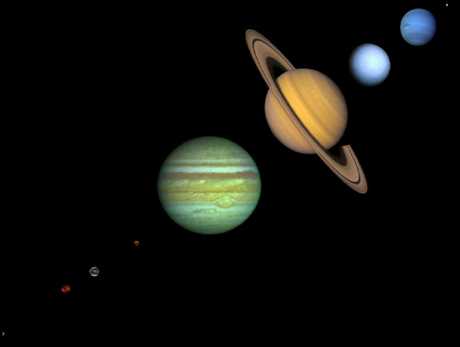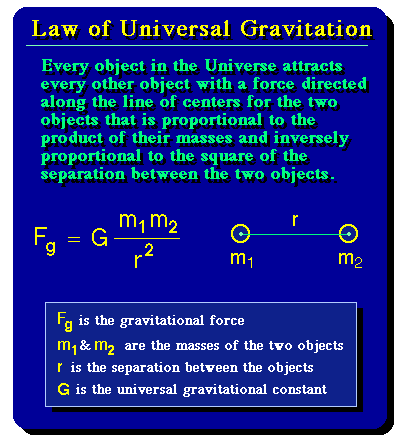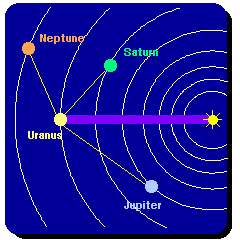 Gravitational Perturbations
Gravitational Perturbations
and the Prediction of New Planets
Computing the orbit of the Earth as an ellipse around the center of mass for
the Earth-Sun system assumes that they are the only two masses in the Universe.
In reality, the Universal Law of Gravitation implies that the Earth interacts
gravitationally not only with the Sun, but with every other mass in the
Universe: the Moon, the other planets, asteroids and comets, the distant
stars.
The Two-Body Approximation
However, from the form of the
gravitational force

we see that
the interactions are largest when two situations are fulfilled:
(1) the product of the masses of the two objects is large, which maximizes the
numerator of the expression for the strength of the gravitational force,
and (2) the
objects are near each other, which minimizes the denominator of the force
equation.
The two-body approximation
that the orbits of the planets are determined only by the
gravitational interaction between the Sun and the planet is possible because
- The Sun is so massive compared with every other object in the Solar System,
- Objects outside the Solar System such as stars are so distant that the
distance squared factor in the denominator renders their gravitational
interactions with the planets negligible.
For example, the Sun is about 300,000 times more massive than the Earth, and
about 1000 times more massive than the largest planet. Thus, the
product of the mass of a planet and the mass of the Sun is always much larger
than the product of the masses of any two planets, and it is a good initial
approximation to neglect all interactions except that of the planet and the
Sun.
Gravitational Perturbations
However, the small deviations from this ideal picture have
consequences
if careful measurements are made. These small deviations from the simplified
picture are called
perturbations. They can be calculated systematically using Newton's
laws of motion and gravitation from the positions of the known masses in the
Solar System.
If we account carefully for all known gravitational
perturbations on the motion of observed planets and the motion of the planet
still deviates from the prediction, there are two options:
- Newton's Law of Gravitation requires modification,
- There is a previously undetected mass that is perturbing the orbits of the
observed planets.
We shall see that the history of astronomy following the introduction of the
Law of Gravitation by Newton gives examples of both.
The Discovery of the New Planet Neptune
 In 1846, the planet Neptune
was discovered after its existence was predicted because of
discrepancies between calculations and data for the planet Uranus.
Astronomers found the new planet almost exactly at the position predicted by the
calculations of Leverrier (Adams had also calculated the position
independently). We illustrate the situation schematically in the adjacent
diagram. The dominant interaction between Uranus and the Sun is indicated with
the heavy line, but some perturbations associated with other masses are
indicated by thin lines. By using Newton's laws to calculate the perturbations
on the orbit of Uranus by an hypothesized new planet, Leverrier and Adams were
able to predict where the planet had to be in order to cause the observed
deviations in the position of Uranus.
Once astronomers took this calculation seriously, they found the new
planet within hours of turning their telescopes on the region of the
sky implicated by the calculations.
In 1846, the planet Neptune
was discovered after its existence was predicted because of
discrepancies between calculations and data for the planet Uranus.
Astronomers found the new planet almost exactly at the position predicted by the
calculations of Leverrier (Adams had also calculated the position
independently). We illustrate the situation schematically in the adjacent
diagram. The dominant interaction between Uranus and the Sun is indicated with
the heavy line, but some perturbations associated with other masses are
indicated by thin lines. By using Newton's laws to calculate the perturbations
on the orbit of Uranus by an hypothesized new planet, Leverrier and Adams were
able to predict where the planet had to be in order to cause the observed
deviations in the position of Uranus.
Once astronomers took this calculation seriously, they found the new
planet within hours of turning their telescopes on the region of the
sky implicated by the calculations.
This precise prediction of the new planet and its
location was striking confirmation of the power of Newton's theory of
gravitation. (Although in truth it must be said that both Leverrier and Adams
made an incorrect assumption in their calculations concerning the radius of the
new planet's orbit. Fortunately, the error largely cancelled out of the
calculations and had little effect on their final results.)
The Accidental Discovery of Pluto
Later, similar calculations on supposed perturbations of the orbits of Uranus
and Neptune suggested the presence of yet another planet beyond the orbit of
Neptune. Eventually, in 1930, a new planet Pluto was discovered, but we now
know that the calculations in this case were also in error because of an
incorrect assumption about the mass of the new planet. It is now believed that
the supposed deviations in the orbits of Neptune and Uranus were errors in
measurement because the actual properties of Pluto would not have accounted for
the supposed perturbations. Thus, the
discovery of Pluto
was a kind of accident.
Effects Beyond Newtonian Perturbations
The power of Newton's theory became apparent as detailed
calculations accounted more and more precisely for the orbits of the planets.
Any deviations from the expected behavior soon became viewed as evidence for
unseen masses in the Solar System. However, later
observations of anomalies in the orbit of Mercury could not be accounted for by
the gravitational perturbation of a new planet
(the hypothetical new planet, which turned out not to exist, was called
Vulcan).
As we discuss in the next
section, early in this century this forced the replacement of
Newton's Law of Gravitation with Einstein's Theory of
General Relativity.

 Gravitational Perturbations
Gravitational Perturbations
 In 1846, the planet Neptune
was discovered after its existence was predicted because of
discrepancies between calculations and data for the planet Uranus.
Astronomers found the new planet almost exactly at the position predicted by the
calculations of Leverrier (Adams had also calculated the position
independently). We illustrate the situation schematically in the adjacent
diagram. The dominant interaction between Uranus and the Sun is indicated with
the heavy line, but some perturbations associated with other masses are
indicated by thin lines. By using Newton's laws to calculate the perturbations
on the orbit of Uranus by an hypothesized new planet, Leverrier and Adams were
able to predict where the planet had to be in order to cause the observed
deviations in the position of Uranus.
Once astronomers took this calculation seriously, they found the new
planet within hours of turning their telescopes on the region of the
sky implicated by the calculations.
In 1846, the planet Neptune
was discovered after its existence was predicted because of
discrepancies between calculations and data for the planet Uranus.
Astronomers found the new planet almost exactly at the position predicted by the
calculations of Leverrier (Adams had also calculated the position
independently). We illustrate the situation schematically in the adjacent
diagram. The dominant interaction between Uranus and the Sun is indicated with
the heavy line, but some perturbations associated with other masses are
indicated by thin lines. By using Newton's laws to calculate the perturbations
on the orbit of Uranus by an hypothesized new planet, Leverrier and Adams were
able to predict where the planet had to be in order to cause the observed
deviations in the position of Uranus.
Once astronomers took this calculation seriously, they found the new
planet within hours of turning their telescopes on the region of the
sky implicated by the calculations.